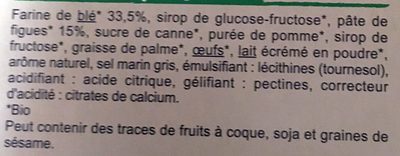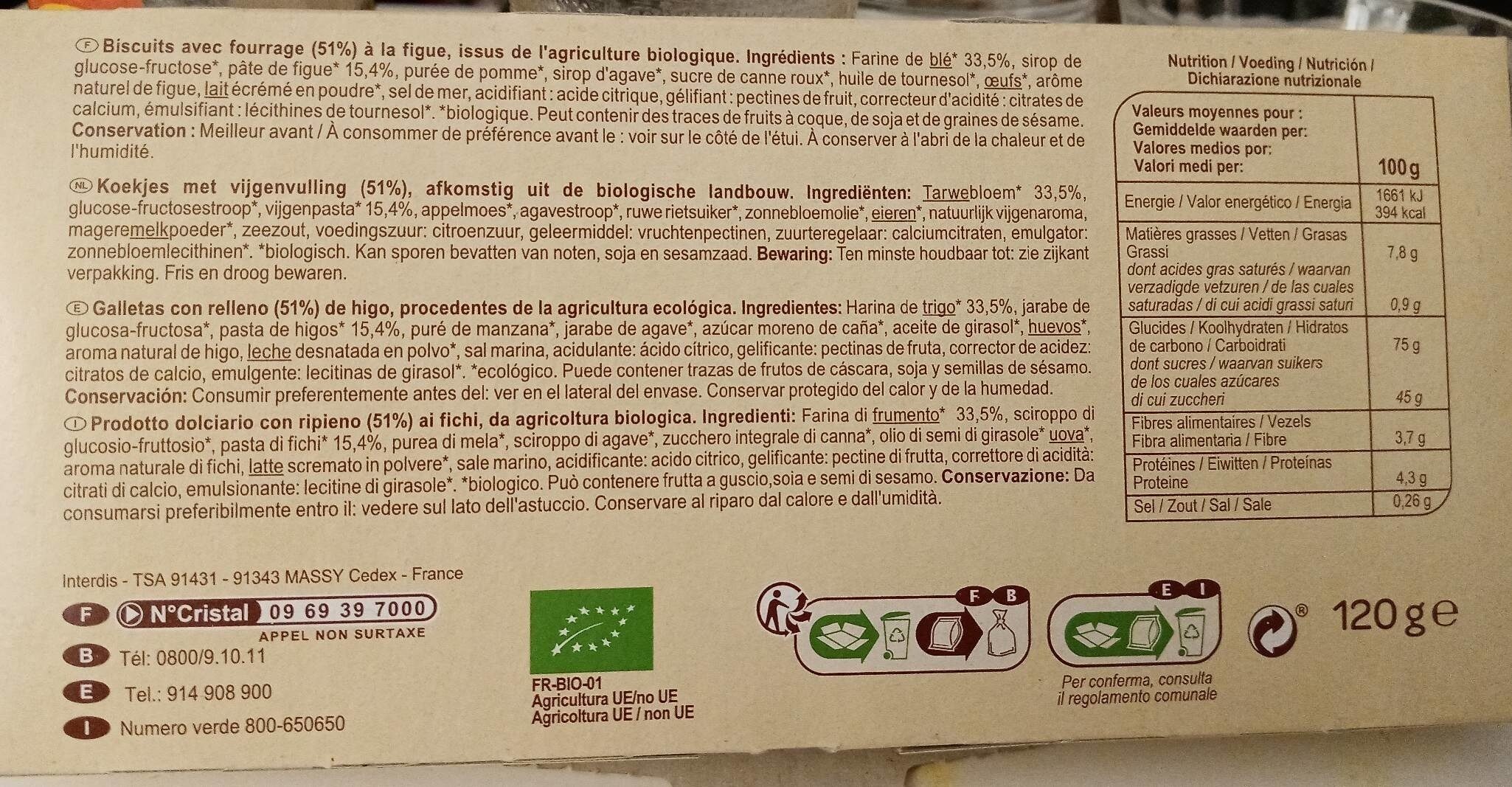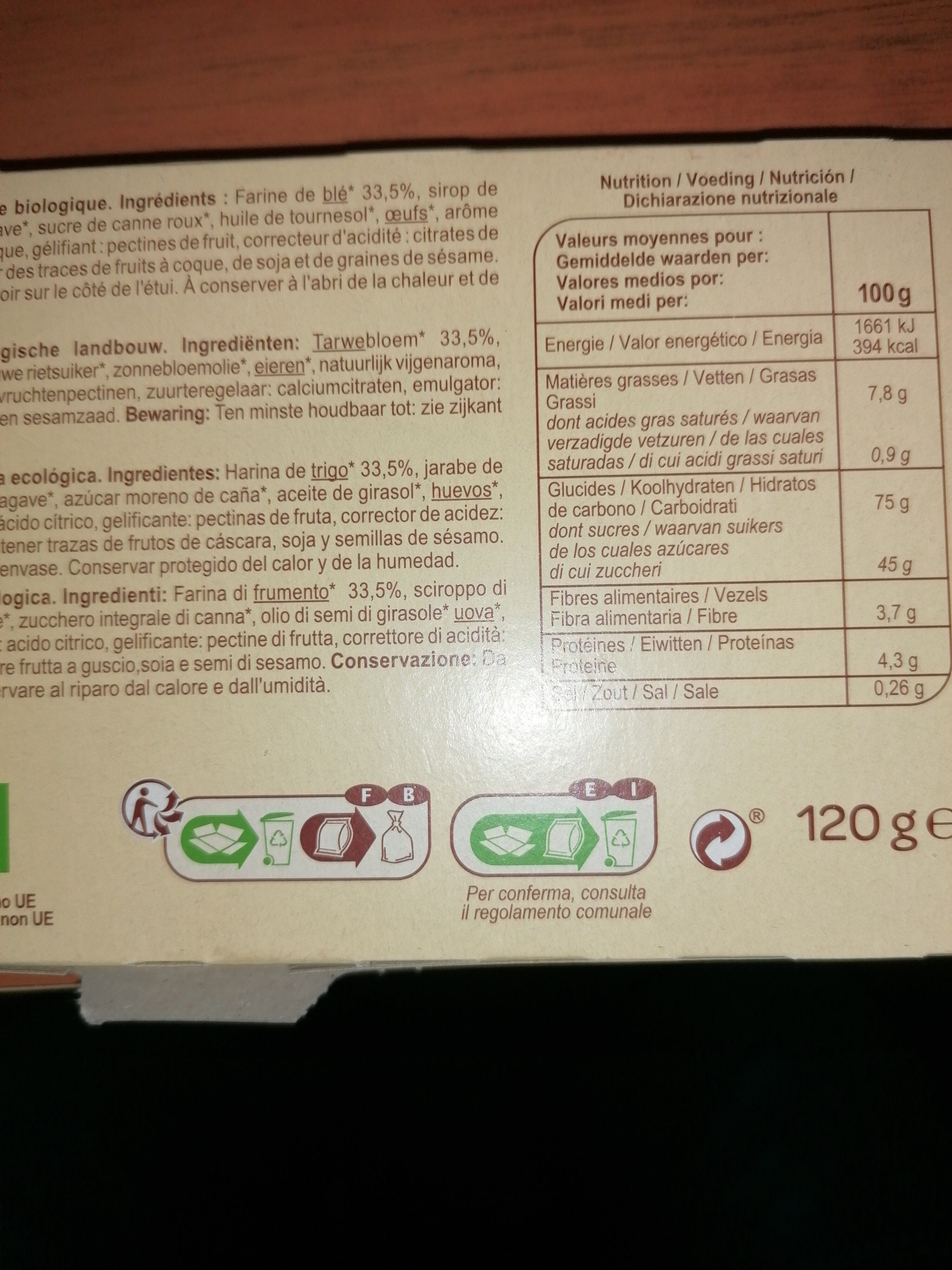Help us make food transparency the norm!
As a non-profit organization, we depend on your donations to continue informing consumers around the world about what they eat.
The food revolution starts with you!
Barre à la figue - Carrefour - 120 g
Barre à la figue - Carrefour - 120 g
Some of the data for this product has been provided directly by the manufacturer Carrefour.
Barra-kodea: 3560071097615 (EAN / EAN-13)
Izen arrunta: Barre à la Figue
Kopurua: 120 g
Ontziratzea: en:Plastic, en:Cardboard, en:Box
Markak: Carrefour, Carrefour Bio
Kategoriak: en:Snacks, en:Sweet snacks, en:Bars, en:Biscuits and cakes, Gaileta, en:Filled biscuits, en:Fruit biscuits
Etiketak, ziurtagiriak, sariak:
en:Organic, en:EU Organic, en:Non-EU Agriculture, en:EU Agriculture, en:EU/non-EU Agriculture, FR-BIO-01, en:Green Dot, en:Made in France, en:No palm oil, Nutriscore, Nutriscore D, AB Agriculture Biologique


Origin of ingredients: Europar Batasuna, Turkia
Manufacturing or processing places: France, BOUVARD BISCUITS S.A.
Traceability code: EMB 26010 - Anneyron (Drôme, France)
Dendak: Carrefour, carrefour.fr
Matching with your preferences
Health
Osagaiak
-
19 ingredients
Frantses: Farine de blé 33,5 %, sirop de glucose-fructose, pâte de figues 15 %, sucre de canne, purée de pomme, sirop de fructose, graisse de palme, œufs, lait écrémé en poudre, arôme naturel, sel marin gris, émulsifiant : lécithines (tournesol), acidifiant : acide citrique, gélifiant pectines, correcteur d'acidité : citrates de calcium.Alergenoak: en:Eggs, en:Gluten, en:MilkAztarnak: en:Nuts, en:Sesame seeds, en:Soybeans
Food processing
-
Ultra processed foods
Elements that indicate the product is in the 4 - Ultra prozesatutako elikagaiak eta edariak group:
- Gehigarria: E322
- Gehigarria: E440 - Pektina
- Osagaia: Emulsifier
- Osagaia: Flavouring
- Osagaia: Gelling agent
- Osagaia: Glukosa
Food products are classified into 4 groups according to their degree of processing:
- Prozesatu gabeko edo ahalik eta gutxien prozesatutako elikagaiak
- Sukaldaritzako osagaiak prozesatu
- Prozesatutako jakiak
- Ultra processed foods
The determination of the group is based on the category of the product and on the ingredients it contains.
Gehigarriak
-
E322
Lecithin: Lecithin -UK: , US: , from the Greek lekithos, "egg yolk"- is a generic term to designate any group of yellow-brownish fatty substances occurring in animal and plant tissues, which are amphiphilic – they attract both water and fatty substances -and so are both hydrophilic and lipophilic-, and are used for smoothing food textures, dissolving powders -emulsifying-, homogenizing liquid mixtures, and repelling sticking materials.Lecithins are mixtures of glycerophospholipids including phosphatidylcholine, phosphatidylethanolamine, phosphatidylinositol, phosphatidylserine, and phosphatidic acid.Lecithin was first isolated in 1845 by the French chemist and pharmacist Theodore Gobley. In 1850, he named the phosphatidylcholine lécithine. Gobley originally isolated lecithin from egg yolk—λέκιθος lekithos is "egg yolk" in Ancient Greek—and established the complete chemical formula of phosphatidylcholine in 1874; in between, he had demonstrated the presence of lecithin in a variety of biological matters, including venous blood, in human lungs, bile, human brain tissue, fish eggs, fish roe, and chicken and sheep brain. Lecithin can easily be extracted chemically using solvents such as hexane, ethanol, acetone, petroleum ether, benzene, etc., or extraction can be done mechanically. It is usually available from sources such as soybeans, eggs, milk, marine sources, rapeseed, cottonseed, and sunflower. It has low solubility in water, but is an excellent emulsifier. In aqueous solution, its phospholipids can form either liposomes, bilayer sheets, micelles, or lamellar structures, depending on hydration and temperature. This results in a type of surfactant that usually is classified as amphipathic. Lecithin is sold as a food additive and dietary supplement. In cooking, it is sometimes used as an emulsifier and to prevent sticking, for example in nonstick cooking spray.Source: Wikipedia (Ingeles)
-
E322i - Lezitina
Lecithin: Lecithin -UK: , US: , from the Greek lekithos, "egg yolk"- is a generic term to designate any group of yellow-brownish fatty substances occurring in animal and plant tissues, which are amphiphilic – they attract both water and fatty substances -and so are both hydrophilic and lipophilic-, and are used for smoothing food textures, dissolving powders -emulsifying-, homogenizing liquid mixtures, and repelling sticking materials.Lecithins are mixtures of glycerophospholipids including phosphatidylcholine, phosphatidylethanolamine, phosphatidylinositol, phosphatidylserine, and phosphatidic acid.Lecithin was first isolated in 1845 by the French chemist and pharmacist Theodore Gobley. In 1850, he named the phosphatidylcholine lécithine. Gobley originally isolated lecithin from egg yolk—λέκιθος lekithos is "egg yolk" in Ancient Greek—and established the complete chemical formula of phosphatidylcholine in 1874; in between, he had demonstrated the presence of lecithin in a variety of biological matters, including venous blood, in human lungs, bile, human brain tissue, fish eggs, fish roe, and chicken and sheep brain. Lecithin can easily be extracted chemically using solvents such as hexane, ethanol, acetone, petroleum ether, benzene, etc., or extraction can be done mechanically. It is usually available from sources such as soybeans, eggs, milk, marine sources, rapeseed, cottonseed, and sunflower. It has low solubility in water, but is an excellent emulsifier. In aqueous solution, its phospholipids can form either liposomes, bilayer sheets, micelles, or lamellar structures, depending on hydration and temperature. This results in a type of surfactant that usually is classified as amphipathic. Lecithin is sold as a food additive and dietary supplement. In cooking, it is sometimes used as an emulsifier and to prevent sticking, for example in nonstick cooking spray.Source: Wikipedia (Ingeles)
-
E330 - Azido zitriko
Citric acid: Citric acid is a weak organic acid that has the chemical formula C6H8O7. It occurs naturally in citrus fruits. In biochemistry, it is an intermediate in the citric acid cycle, which occurs in the metabolism of all aerobic organisms. More than a million tons of citric acid are manufactured every year. It is used widely as an acidifier, as a flavoring and chelating agent.A citrate is a derivative of citric acid; that is, the salts, esters, and the polyatomic anion found in solution. An example of the former, a salt is trisodium citrate; an ester is triethyl citrate. When part of a salt, the formula of the citrate ion is written as C6H5O3−7 or C3H5O-COO-3−3.Source: Wikipedia (Ingeles)
-
E333
Calcium citrate: Calcium citrate is the calcium salt of citric acid. It is commonly used as a food additive -E333-, usually as a preservative, but sometimes for flavor. In this sense, it is similar to sodium citrate. Calcium citrate is also found in some dietary calcium supplements -e.g. Citracal-. Calcium makes up 24.1% of calcium citrate -anhydrous- and 21.1% of calcium citrate -tetrahydrate- by mass. The tetrahydrate occurs in nature as the mineral Earlandite.Source: Wikipedia (Ingeles)
-
E440 - Pektina
Pectin: Pectin -from Ancient Greek: πηκτικός pēktikós, "congealed, curdled"- is a structural heteropolysaccharide contained in the primary cell walls of terrestrial plants. It was first isolated and described in 1825 by Henri Braconnot. It is produced commercially as a white to light brown powder, mainly extracted from citrus fruits, and is used in food as a gelling agent, particularly in jams and jellies. It is also used in dessert fillings, medicines, sweets, as a stabilizer in fruit juices and milk drinks, and as a source of dietary fiber.Source: Wikipedia (Ingeles)
Ingredients analysis
-
en:Palm oil
Ingredients that contain palm oil: en:Palm fat
-
en:Non-vegan
Non-vegan ingredients: Arrautza, en:Skimmed milk powder
-
en:Maybe vegetarian
Ingredients that may not be vegetarian: en:Apple puree, en:Natural flavouring
-
Details of the analysis of the ingredients
fr: Farine de blé 33.5%, sirop de glucose-fructose, pâte de figues 15%, sucre de canne, purée de pomme, sirop de fructose, graisse de palme, œufs, lait écrémé en poudre, arôme naturel, sel marin gris, émulsifiant (lécithines de tournesol), acidifiant (acide citrique), gélifiant (pectines), correcteur d'acidité (citrates de calcium)- Farine de blé -> en:wheat-flour - vegan: yes - vegetarian: yes - ciqual_proxy_food_code: 9410 - percent_min: 33.5 - percent: 33.5 - percent_max: 33.5
- sirop de glucose-fructose -> en:glucose-fructose-syrup - vegan: yes - vegetarian: yes - ciqual_food_code: 31077 - percent_min: 15 - percent_max: 33.5
- pâte de figues -> en:fig-paste - vegan: yes - vegetarian: yes - ciqual_food_code: 13012 - percent_min: 15 - percent: 15 - percent_max: 15
- sucre de canne -> en:cane-sugar - vegan: yes - vegetarian: yes - ciqual_proxy_food_code: 31016 - percent_min: 1.5 - percent_max: 15
- purée de pomme -> en:apple-puree - vegan: maybe - vegetarian: maybe - ciqual_food_code: 13050 - percent_min: 0.272727272727273 - percent_max: 15
- sirop de fructose -> en:fructose-syrup - vegan: yes - vegetarian: yes - ciqual_food_code: 31077 - percent_min: 0 - percent_max: 12.4318181818182
- graisse de palme -> en:palm-fat - vegan: yes - vegetarian: yes - from_palm_oil: yes - ciqual_proxy_food_code: 16129 - percent_min: 0 - percent_max: 9.94545454545455
- œufs -> en:egg - vegan: no - vegetarian: yes - ciqual_food_code: 22000 - percent_min: 0 - percent_max: 8.28787878787879
- lait écrémé en poudre -> en:skimmed-milk-powder - vegan: no - vegetarian: yes - ciqual_food_code: 19054 - percent_min: 0 - percent_max: 7.1038961038961
- arôme naturel -> en:natural-flavouring - vegan: maybe - vegetarian: maybe - percent_min: 0 - percent_max: 5
- sel marin gris -> en:grey-salt - vegan: yes - vegetarian: yes - ciqual_food_code: 11083 - percent_min: 0 - percent_max: 0.26
- émulsifiant -> en:emulsifier - percent_min: 0 - percent_max: 0.26
- lécithines de tournesol -> en:sunflower-lecithin - vegan: yes - vegetarian: yes - percent_min: 0 - percent_max: 0.26
- acidifiant -> en:acid - percent_min: 0 - percent_max: 0.26
- acide citrique -> en:e330 - vegan: yes - vegetarian: yes - percent_min: 0 - percent_max: 0.26
- gélifiant -> en:gelling-agent - percent_min: 0 - percent_max: 0.26
- pectines -> en:e440a - vegan: yes - vegetarian: yes - percent_min: 0 - percent_max: 0.26
- correcteur d'acidité -> en:acidity-regulator - percent_min: 0 - percent_max: 0.26
- citrates de calcium -> en:e333 - vegan: yes - vegetarian: yes - percent_min: 0 - percent_max: 0.26
Elikadura
-
Poor nutritional quality
This product is not considered a beverage for the calculation of the Nutri-Score.
Positive points: 4
- Proteinak: 2 / 5 (balioa: 4.3, rounded value: 4.3)
- Fiber: 4 / 5 (balioa: 3.8, rounded value: 3.8)
- Fruits, vegetables, nuts, and colza/walnut/olive oils: 0 / 5 (balioa: 15, rounded value: 15)
Negative points: 15
- Energia: 4 / 10 (balioa: 1661, rounded value: 1661)
- Azukreak: 10 / 10 (balioa: 46, rounded value: 46)
- Gantz saturatua: 0 / 10 (balioa: 0.9, rounded value: 0.9)
- Sodioa: 1 / 10 (balioa: 104, rounded value: 104)
The points for proteins are not counted because the negative points are greater or equal to 11.
Nutritional score: (15 - 4)
Nutri-Score:
-
Nutrient levels
-
Koipe in moderate quantity (8.5%)
What you need to know- A high consumption of fat, especially saturated fats, can raise cholesterol, which increases the risk of heart diseases.
Recommendation: Limit the consumption of fat and saturated fat- Choose products with lower fat and saturated fat content.
-
Gantz-azido ase in low quantity (0.9%)
What you need to know- A high consumption of fat, especially saturated fats, can raise cholesterol, which increases the risk of heart diseases.
Recommendation: Limit the consumption of fat and saturated fat- Choose products with lower fat and saturated fat content.
-
Azukre in high quantity (46%)
What you need to know- A high consumption of sugar can cause weight gain and tooth decay. It also augments the risk of type 2 diabetes and cardio-vascular diseases.
Recommendation: Limit the consumption of sugar and sugary drinks- Sugary drinks (such as sodas, fruit beverages, and fruit juices and nectars) should be limited as much as possible (no more than 1 glass a day).
- Choose products with lower sugar content and reduce the consumption of products with added sugars.
-
Gatz arrunt in low quantity (0.26%)
What you need to know- A high consumption of salt (or sodium) can cause raised blood pressure, which can increase the risk of heart disease and stroke.
- Many people who have high blood pressure do not know it, as there are often no symptoms.
- Most people consume too much salt (on average 9 to 12 grams per day), around twice the recommended maximum level of intake.
Recommendation: Limit the consumption of salt and salted food- Reduce the quantity of salt used when cooking, and don't salt again at the table.
- Limit the consumption of salty snacks and choose products with lower salt content.
-
-
Nutrition facts
Nutrition facts As sold
for 100 g / 100 mlAs sold
per serving (20 g)Compared to: en:Fruit biscuits Energia 1.661 kj
(402 kcal)332 kj
(80 kcal)-% 13 Koipe 8,5 g 1,7 g -% 54 Gantz-azido ase 0,9 g 0,18 g -% 92 Carbohydrates 75 g 15 g +% 15 Azukre 46 g 9,2 g +% 46 Fiber 3,8 g 0,76 g Proteina 4,3 g 0,86 g -% 15 Gatz arrunt 0,26 g 0,052 g -% 55 Fruits‚ vegetables‚ nuts and rapeseed‚ walnut and olive oils 15 % 15 % Fruits‚ vegetables‚ nuts and rapeseed‚ walnut and olive oils (estimate from ingredients list analysis) 22,636 % 22,636 %
Ingurumena
-
Eco-Score B - Ingurumen-eragin txikia
The Eco-Score is an experimental score that summarizes the environmental impacts of food products.→ The Eco-Score was initially developped for France and it is being extended to other European countries. The Eco-Score formula is subject to change as it is regularly improved to make it more precise and better suited to each country.Life cycle analysis
-
Average impact of products of the same category: B (Score: 69/100)
Kategoria: Biscuit (cookie)
Kategoria: Biscuit (cookie)
- PEF environmental score: 0.35 (the lower the score, the lower the impact)
- including impact on climate change: 2.88 kg CO2 eq/kg of product
Stage Impact Agriculture
80.5 %Processing
11.8 %Ontziratzea
3.1 %Transportation
3.2 %Distribution
1.4 %Consumption
0.0 %
Bonuses and maluses
-
Labels with high environmental benefits
Bonus: +15
-
AB Agriculture Biologique
Organic agriculture contributes to preserve biodiversity, climate, water quality and soil fertility.
Organic food is food produced by methods complying with the standards of organic farming and features practices that cycle resources, promote ecological balance, and conserve biodiversity.
-
EU Organic
Organic agriculture contributes to preserve biodiversity, climate, water quality and soil fertility.
Organic food is food produced by methods complying with the standards of organic farming and features practices that cycle resources, promote ecological balance, and conserve biodiversity.
-
-
Origins of ingredients with a high impact
Malus: -1
Environmental policy: -5
Transportation: +4
Origin of the product and/or its ingredients % of ingredients Impact Europar Batasuna 50 %Altua Turkia 50 %Medium
-
Ingredients that threatens species
Malus: -10
Contains palm oil
Tropical forests in Asia, Africa and Latin America are destroyed to create and expand oil palm tree plantations. The deforestation contributes to climate change, and it endangers species such as the orangutan, the pigmy elephant and the Sumatran rhino.
-
Packaging with a medium impact
Malus: -11
Shape Material Recycling Impact 6 Individual bag Plastic Altua Box Cardboard Baxua
Eco-Score for this product
-
Impact for this product: B (Score: 62/100)
Produktua: Barre à la figue - Carrefour - 120 g
Life cycle analysis score: 69
Sum of bonuses and maluses: -7
Final score: 62/100
-
Carbon footprint
-
Equal to driving 1.5 km in a petrol car
288 g CO² per 100g of product
The carbon emission figure comes from ADEME's Agribalyse database, for the category: Biscuit (cookie) (Source: ADEME Agribalyse Database)
Stage Impact Agriculture
82.9 %Processing
7.9 %Ontziratzea
3.8 %Transportation
4.7 %Distribution
0.7 %Consumption
0.0 %
Ontziratzea
-
Packaging with a medium impact
-
Packaging parts
6 x Individual bag 20 g (Plastic: 0.41 g)
Box 120 g (Cardboard: 24 g)
-
Bilgarriaren materialak
Material % Bilgarriaren pisua Bilgarriaren pisua produktuaren 100g-ko Paper or cardboard 90.7% 24 g 20 g Plastic 9.3% 2.46 g 2.1 g Guztira 100% 26.46 g 22 g
-
Transportation
-
Origins of ingredients
Origins of ingredients with a high impact
Origin of the product and/or its ingredients % of ingredients Impact Europar Batasuna 50 %Altua Turkia 50 %Medium
Threatened species
-
Contains palm oil
Drives deforestation and threatens species such as the orangutan
Tropical forests in Asia, Africa and Latin America are destroyed to create and expand oil palm tree plantations. The deforestation contributes to climate change, and it endangers species such as the orangutan, the pigmy elephant and the Sumatran rhino.
Etiketak
-
AB Agriculture Biologique
Organic agriculture contributes to preserve biodiversity, climate, water quality and soil fertility.
Organic food is food produced by methods complying with the standards of organic farming and features practices that cycle resources, promote ecological balance, and conserve biodiversity.
-
EU Organic
Organic agriculture contributes to preserve biodiversity, climate, water quality and soil fertility.
Organic food is food produced by methods complying with the standards of organic farming and features practices that cycle resources, promote ecological balance, and conserve biodiversity.
Other information
Conservation conditions: Meilleur avant / A consommer de préférence avant le : voir sur le côté de l'étui. A conserver à l'abri de la chaleur et de l'humidité.
Customer service: Interdis - TSA 91431 - 91343 MASSY Cedex France
Report a problem
-
Incomplete or incorrect information?
Category, labels, ingredients, allergens, nutritional information, photos etc.
If the information does not match the information on the packaging, please complete or correct it. Open Food Facts is a collaborative database, and every contribution is useful for all.
Datuen iturria
Product added on by kiliweb
Last edit of product page on by bcd4e6.
Produktuaren orria -gatik editatua aleene, annelotte, beniben, driveoff, ecoscore-impact-estimator, hhassan, openfoodfacts-contributors, org-carrefour, packbot, psine, quechoisir, roboto-app, yuka.U0lraktZc0h2LzRCeHMwUDNpenk5ZjlUK0pxeGYwMndCdWdESVE9PQ, yuka.U0xndU9aUTUrZUpXaGZaazN6bnJ5bzFLMkpHeFltK0dFY0E0SVE9PQ, yuka.ZXB3WlRLMERscWcxbjhKbDh4Ylk4ZnhWbTZDMVVHU3FLdTlQSUE9PQ, yuka.sY2b0xO6T85zoF3NwEKvlhB2beqOgyzfBzbigxO7zfHVB5eyRddv5YvQGas, yuka.sY2b0xO6T85zoF3NwEKvlhZ5TuHwqG3hERXfh2LV9tWOFY3PWY5NvpTEHqo, yuka.sY2b0xO6T85zoF3NwEKvlhd7WvDv-w-aby3Wq2ra2c7WEY3NTPFjw7bELag, yuka.sY2b0xO6T85zoF3NwEKvllRna__hv2PfHTjhxW-a2sW0IK3jTd9j59OkLqs.















